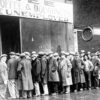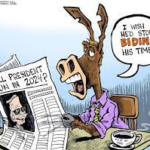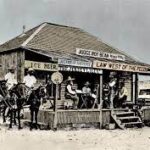Where Will This Political Violence Lead? Look to the 1850s.
![]()
In the mid-19th century, a pro-slavery minority — encouraged by lawmakers — used violence to stifle a growing anti-slavery majority. It wasn’t long before the other side embraced force as a necessary response.

The destruction of the city of Lawrence, Kansas, and the massacre of its inhabitants by the Rebel guerrillas, August 21, 1863. Quantrill’s Raid. | Wikimedia Commons
By JOSHUA ZEITZ
10/29/2022 01:10 PM EDT
Early Friday morning, an intruder broke into the San Francisco home of House Speaker Nancy Pelosi and bludgeoned her husband, Paul Pelosi, 82, on the head with a hammer.
Details are still scant, but early indications suggest that the suspect, David Depape, is an avid purveyor of anti-Semitic, QAnon and MAGA conspiracy theories. Before the attack, the assailant reportedly shouted, “Where is Nancy? Where is Nancy?”
This is the United States of America in 2022. A country where political violence — including the threat of political violence — has become a feature, not a bug.
Armed men wearing tactical gear and face coverings outside ballot drop boxes in Arizona. Members of Congress threatening to bring guns onto the House floor — or actually trying to do it. Prominent Republican members of Congress, and their supporters on Fox News, stoking violence against their political opponents by accusing them of being pedophiles, terrorists and groomers — of conspiring with “globalists” (read: Jews) to “replace” white people with immigrants.
And of course, January 6, and subsequent efforts by Republicans and conservative media personalities to whitewash or even celebrate it.
Pundits like to take refuge in the saccharine refrain, “this is not who we are,” but historically, this is exactly who we are. Political violence is an endemic feature of American political history. It was foundational to the overthrow of Reconstruction in the 1870s and the maintenance of Jim Crow for decades after.
But today’s events bear uncanny resemblance to an earlier decade — the 1850s, when Southern Democrats, the conservatives of their day, unleashed a torrent of violence against their opponents. It was a decade when an angry and entrenched minority used force to thwart the will of a growing majority, often with the knowing support and even participation of prominent elected officials.
That’s the familiar part of the story. The less appreciated angle is how that growing majority eventually came to accept the proposition that force was a necessary part of politics.
The 1850s were a singularly violent era in American politics. Though politicians both North and South, Whig and Democrat, tried to contain sectional differences over slavery, Southern Democrats and their Northern sympathizers increasingly pushed the envelope, employing coercion and violence to protect and spread the institution of slavery.
It began with the Fugitive Slave Act of 1850, which stripped accused runaways of their right to trial by jury and allowed individual cases to be bumped up from state courts to special federal courts. As an extra incentive to federal commissioners adjudicating such cases, it provided a $10 fee when a defendant was remanded to slavery but only $5 for a finding rendered against the slave owner. Most obnoxious to many Northerners, the law stipulated harsh fines and prison sentences for any citizen who refused to cooperate with or aid federal authorities in the capture of accused fugitives. Southern Democrats enforced the law with brute force, to the horror of Northerners, including many who did not identify as anti-slavery.
The next provocation was the Kansas Nebraska Act of 1854, which effectively abrogated the Missouri Compromise and opened the western territories to slavery. It wasn’t enough that Democrats rammed through legislation allowing the citizens of the Kansas and Nebraska territories to institutionalize slavery if they voted to do so in what had long been considered free territory. They then employed coercion and violence to rig the territorial elections that followed.
Though anti-slavery residents far outnumbered pro-slavery residents in Kansas, heavily armed “Border ruffians,” led by Missouri’s Democratic senator David Atchison, stormed the Kansas territory by force, stuffing ballot boxes, assaulting and even killing Free State settlers, in a naked attempt to tilt the scales in favor of slavery. “You know how to protect your own interests,” Atchison cried. “Your rifles will free you from such neighbors. … You will go there, if necessary, with the bayonet and with blood.” He promised, “If we win, we can carry slavery to the Pacific Ocean.”
The violence made it into Congress. When backlash against the Kansas Nebraska Act upended the political balance, driving anti-slavery Democrats and Whigs into the new, anti-slavery Republican party, pro-slavery Democrats responded with rage. In 1856, Charles Sumner, a staunch anti-slavery Republican, delivered a speech entitled “The Crime Against Kansas.” In response, a Democratic congressman from South Carolina beat him nearly to death on the Senate floor with a steel-tipped cane — not entirely dissimilar from the hammer-wielding conspiracy theorist who attempted to murder Paul Pelosi Friday.
“Bleeding Sumner,” as the outrage came to be known, was not a one-off. Pro-slavery congressmen began showing up armed on the House floor. They threatened their Northern colleagues with whippings and beatings. They talked openly of civil war and rebellion.
In some ways, none of this was new. Pro-slavery forces had long been violent and anti-democratic. When abolitionists in the 1830s began sending anti-slavery literature to Southern slaveholders, the pro-slavery forces tried to ban them from using the postal service. They destroyed the printing presses of abolitionist publishers and, in 1837, famously lynched Elijah P. Lovejoy, an abolitionist clergyman — after dumping his press in the river.
MOST READ
- No-show Joe: Biden leaves Trudeau, Canada hanging
- Paul Pelosi told attacker he needed to use the bathroom, called 911 from there
- Justice Dept. warns ruling in Trump ally’s suit could endanger U.S. diplomats
- Pelosi attacker was immersed in 2020 election conspiracies
- Colleges brace themselves for SCOTUS loss on race-conscious admissions

































![Lieutenant-Colonel Robert Rogers (7 November 1731 – 18 May 1795) was a British Army officer and frontiersman. Born in Methuen, Massachusetts, he fought in King George’s War, the French and Indian War and the American Revolutionary War. During the French and Indian War, Rogers raised and commanded Rogers’ Rangers, a ranger unit trained for carrying out asymmetric warfare.[2][3](https://www.cowboyron.com/wp-content/uploads/2022/05/1262463_580743685323360_2133853937_o1-1-150x150.jpg)
















![Billie Joe Armstrong & Norah Jones – Silver Haired Daddy Of Mine [Music Video]](https://www.cowboyron.com/wp-content/uploads/2022/11/Al_St._John1-100x100.jpg)























